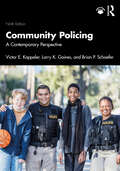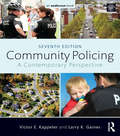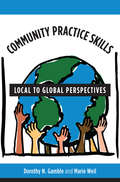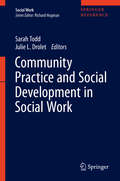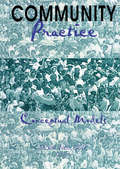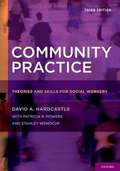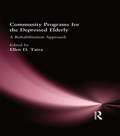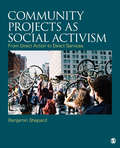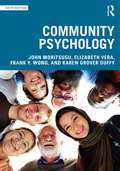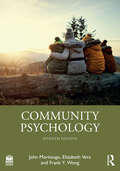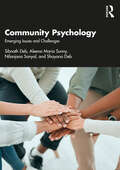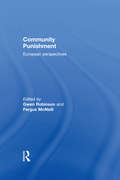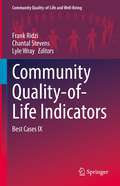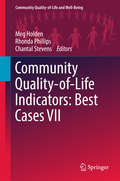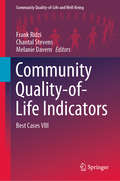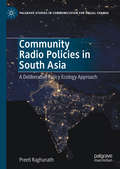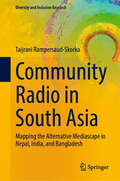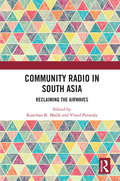- Table View
- List View
Community Policing: A Contemporary Perspective
by Victor E. Kappeler Larry K. Gaines Brian P. SchaeferCommunity Policing: A Contemporary Perspective, 8th Edition, provides comprehensive coverage of the philosophy and organizational strategy that expands the traditional police mandate of fighting crime to include forming partnerships with citizenry that endorse mutual support and participation. The first textbook of its kind, Community Policing delineates this progressive approach, combining the accrued wisdom and experience of its established authors with the latest research-based insights to help students apply what is on the page to the world beyond. The book extends the road map presented by Robert Trojanowicz, the father of community policing, and brings it into contemporary focus. The text has been revised throughout to include the most current developments in the field, including discussions of the President’s Task Force on 21st Century Policing and "Spotlight on Community Policing Practice" features that focus on real-life community policing programs in various cities as well as problem-solving case studies. Also assisting the reader in understanding the material are Learning Objectives, Key Terms, and Discussion Questions, in addition to numerous links to resources outside the text. A glossary and an appendix, "The Ten Principles of Community Policing," further enhance learning of the material. An excellent resource for any undergraduate Policing curriculum, this textbook is also suitable for introducing graduate students to the principles of community policing.
Community Policing: A Contemporary Perspective
by Victor E. Kappeler Larry K. Gaines Brian P. SchaeferThis book provides comprehensive coverage of community policing, the philosophy and organizational strategy that expands the traditional police mandate of fighting crime to include forming partnerships with citizenry that endorse mutual support and participation. The first textbook of its kind, Community Policing delineates this progressive approach, combining the accrued wisdom and experience of its established authors with the latest research-based insights to help students apply what is on the page to the world beyond.The book extends the road map presented by Robert Trojanowicz, the father of community policing, and brings it into contemporary focus. The text has been revised throughout to include the most current developments in the field, including discussions of the 2020 protests and subsequent calls for police reform, and the rapid development of alternative responses for behavioral health and other non-criminal 911 calls. “Spotlight on Community Policing Practice” features throughout the text focus on real-life community policing programs in various cities as well as problem-solving case studies. Also assisting the reader in understanding the material are Learning Objectives, Key Terms, and Discussion Questions, in addition to numerous links to resources outside the text.An excellent resource for any undergraduate policing or law enforcement curriculum, this textbook is also suitable for introducing graduate students to the principles of community policing.
Community Policing: A Contemporary Perspective (7th Edition)
by Victor E. Kappeler Larry K. GainesCommunity policing is a philosophy and organizational strategy that expands the traditional police mandate of fighting crime to include forming partnerships with citizenry that endorse mutual support and participation. The first textbook of its kind, Community Policing: A Contemporary Perspective delineates this progressive approach, combining the accrued wisdom and experience of its established authors with the latest research-based insights to help students apply what is on the page to the world beyond. This seventh edition extends the road map presented by Robert Trojanowicz, the father of community policing, and brings it into contemporary focus. The text has been revised throughout to include the most current developments in the field, including "Spotlight on Community Policing Practice" features that focus on real-life community policing programs in various cities as well as problem-solving case studies. Also assisting the reader in understanding the material are Learning Objectives, Key Terms, and Discussion Questions, in addition to numerous links to resources outside the text. A glossary and an appendix, "The Ten Principles of Community Policing," further enhance learning of the material.
Community Policing: International Patterns and Comparative Perspectives (Advances in Police Theory and Practice)
by Dominique Wisler Ihekwoaba D. OnwudiweCommunity-oriented policing (COP) is the ideology and policy model espoused in the mission statements of nearly all policing forces throughout the world. However, the COP philosophy is interpreted differently by different countries and police forces, resulting in practices that may in fact run far afield of the community-based themes of partnership
Community Practice Skills: Local to Global Perspectives
by Marie Weil Dorothy GambleDorothy N. Gamble and Marie Weil differentiate among a range of intervention methods to provide a comprehensive and effective guide to working with communities. Presenting eight distinct models grounded in current practice and targeted toward specific goals, Gamble and Weil take an unusually inclusive step, combining their own extensive experience with numerous case and practice examples from talented practitioners in international and domestic settings.The authors open with a discussion of the theories for community work and the values of social justice and human rights, concerns that have guided the work of activists from Jane Addams and Martin Luther King Jr. to Cesar Chavez, Wangari Maathai, and Vandana Shiva. They survey the concepts, knowledge, and perspectives influencing community practice and evaluation strategies. Descriptions of eight practice models follow, incorporating real-life case examples from many parts of the world and demonstrating multiple applications for each model as well as the primary roles, competencies, and skills used by the practitioner. Complexities and variations encourage readers to determine, through comparative analysis, which model at which time best fits the goals of a community group or organization, given the context, culture, social, economic, and environmental issues and opportunities for change. An accompanying workbook stressing empowerment strategies and skills development is also available from Columbia University Press.
Community Practice Skills: Local to Global Perspectives
by Marie Weil Dorothy N. GambleDorothy N. Gamble and Marie Weil differentiate among a range of intervention methods to provide a comprehensive and effective guide to working with communities. Presenting eight distinct models grounded in current practice and targeted toward specific goals, Gamble and Weil take an unusually inclusive step, combining their own extensive experience with numerous case and practice examples from talented practitioners in international and domestic settings. The authors open with a discussion of the theories for community work and the values of social justice and human rights, concerns that have guided the work of activists from Jane Addams and Martin Luther King Jr. to Cesar Chavez, Wangari Maathai, and Vandana Shiva. They survey the concepts, knowledge, and perspectives influencing community practice and evaluation strategies. Descriptions of eight practice models follow, incorporating real-life case examples from many parts of the world and demonstrating multiple applications for each model as well as the primary roles, competencies, and skills used by the practitioner. Complexities and variations encourage readers to determine, through comparative analysis, which model at which time best fits the goals of a community group or organization, given the context, culture, social, economic, and environmental issues and opportunities for change. An accompanying workbook stressing empowerment strategies and skills development is also available from Columbia University Press.
Community Practice and Social Development in Social Work (Social Work)
by Julie L. Drolet Sarah ToddThis book brings together leaders in the field of community practice and social development in social work. The chapters discuss the implications of social development in social work practice, policy, and service structures.
Community Practice: Conceptual Models
by Marie WeilHere is the only book that gives you a comparison of model frameworks and a critique of multiple perspectives. Community Practice: Conceptual Models (along with its companion volume, Community Practice: Models in Action) illustrates the diverse ways that community practice is conceived and delineates both the central and subtle differences among models to guide community assessment, action planning, and practice. By knitting together the complex ideas from the social sciences and community practice, this book shows how to combine these ideas to improve teaching, practice, analysis, and research for social work faculty; social work students; practitioners in community work, administration, and social planning; and faculty of related disciplines.The scope of Community Practice: Conceptual Models is broad, providing the first historical report on model development and implementation since 1965. Its chapters present diverse views on community practice approaches and provide the compilation, critique, and analysis of current models --while illustrating how these approaches developed over time. Included is Rothman’s long-awaited revision and elaboration of his 1970s classic, three models conceptual framework. Other vital topics you learn about include: collaborative community development social planning, reform movements, and social action ecological theory in community practice a feminist response and critique to Rothman’s approaches to community intervention a comparison of community practice in the U.S. and U.K., with an emphasis on nonracist practice and community-based service developmentCommunity Practice: Conceptual Models offers challenges and indicates directions for practice, theory elaboration, testing, and research and shows community practice in relation to characteristics such as goals and desired outcomes, change strategies, targets of change, primary constituencies, and focus or scope of concern. This book provides the strongest perspectives on community practice to help you improve your practice, assessments, action plans, and research.
Community Practice: Theories and Skills for Social Workers
by David A. Hardcastle Patricia R. Powers Stanley WenocurFor almost two decades, Community Practice has been a definitive text for social workers, community practitioners, and students eager to help individuals contribute to and use community resources or work to change oppressive community structures. In this third edition, a wealth of new charts and cases spotlight the linkages between theoretical orientations and practical skills, with an enhanced emphasis on the inherently political nature of social work and community practice.
Community Prevention of Child Labor: Evidence-based Practices to Promote the Psychological Well-being of Minors (Human Well-Being Research and Policy Making)
by Isidro Maya JariegoThis book discusses preventive actions that have led to reduction in the prevalence of child labor across the world over the 21st century. It identifies exemplary programs in the area of community prevention that have had exceptional results; for example, the involvement of children in hazardous work globally being reduced by half. It documents a wide range of contexts where concerted action has counteracted social permissiveness towards child labor, including psycho-educational interventions in preventing early school leaving and conditional cash benefits which counteract family poverty. The book presents a set of evidence-based practices that are particularly useful for psychologists, educators, and social workers. More broadly, this book is also of interest to policymakers, professionals, and activists involved in child protection policy or in implementing programs to promote the psychological well-being of children.
Community Programs for the Depressed Elderly: A Rehabilitation Approach
by Ellen D TairaInternational experts offer insights into rehabilitative work with the depressed elderly, including examples of successful treatment models, assessment and prevention techniques, as well as other helpful methods of alleviating depression in the institutionalized elderly.
Community Projects as Social Activism: From Direct Action to Direct Services
by Benjamin H. ShepardCommunity Projects as Social Activism: From Direct Action to Direct Services by Benjamin Shepard is an engaging and accessible work that will get today′s students excited about the very real prospect of achieving lasting, positive change within their communities. It outlines a distinct approach to community practice born out of the intersection among social movements, day-to-day organizing, and the lessons of five decades of community change practices. This invaluable resource is a must-have for anyone involved in community organization, community health, and community activism practice research and policy.
Community Projects as Social Activism: From Direct Action to Direct Services
by Benjamin H. ShepardCommunity Projects as Social Activism: From Direct Action to Direct Services by Benjamin Shepard is an engaging and accessible work that will get today′s students excited about the very real prospect of achieving lasting, positive change within their communities. It outlines a distinct approach to community practice born out of the intersection among social movements, day-to-day organizing, and the lessons of five decades of community change practices. This invaluable resource is a must-have for anyone involved in community organization, community health, and community activism practice research and policy.
Community Psychology
by Karen Grover Duffy Frank Y Wong Elizabeth Vera John MoritsuguCommunity Psychology, 6th Edition offers an easy-to-navigate, clearly organized, and comprehensive overview of the field, with theoretical roots that carry over to practical applications. Presenting the concepts of community psychology and social change, these concepts are then applied to various systems addressing the human condition: mental health, medical, public health, school, legal, and industrial/organizational. Through a unique three-part approach, including concepts, interventions, and applications of the theory, the book opens the field of community psychology to students who are interested in how psychology might help themselves and the systems around them. It then focuses on the prevention of problems, the promotion of well-being, the empowerment of members within a community, the appreciation of diversity, and an ecological model for the understanding of human behavior. Attention is paid to both "classic" early writings and the most recent journal articles and reviews by today’s practitioners and researchers. Historical and alternative methods of effecting social change are explored in this book, with the overall theme that the environment is as important as the individual in it. This 6th edition will include new topical subjects such as grit and life success, changes in technology and their impact, interventions based on networking, social movements and justice, dealing with stigma, and new models of health. It will appeal to advanced undergraduates as well as graduates taking courses on community psychology, social psychology, clinical psychology, and related fields.
Community Psychology
by Elizabeth Vera John Moritsugu Frank Y. WongCommunity Psychology, 7th Edition presents the field’s conceptual roots and possible applications in a comprehensive overview of the field. Clearly organized and easy to navigate, the text is divided into sections on basic concepts, social change, applications, and the future.The book opens the field of community psychology to students who are interested in how psychology is relevant to their own lives and the systems around them. The applied chapters discuss how community psychology relates to mental health, social and health services, schools and children, law and crime, health and public health, and community/organizational psychology. The new edition updates research and literature and presents developments in theoretical and research methodologies. This edition focuses particularly on description and consideration of critical theory, liberation theology, and decolonization as part of community psychology’s intellectual and value-based evolution. Examples of community psychology in practice are provided throughout the text, and each chapter also features discussion questions for students to consider. A student website and instructor resources provide further ways to engage with the content and support teaching and learning.This highly engaging book explores social change, the mental health of the community, and the importance of the environment upon the individual. It will appeal to advanced undergraduates as well as graduates taking courses on community psychology, social psychology, clinical psychology, and related fields.
Community Psychology: Emerging Issues and Challenges
by Sibnath Deb Aleena Maria Sunny Nilanjana Sanyal Shayana DebThis book focuses on the theoretical concepts of community psychology and its applications in day-to-day life. It discusses the challenges that adversely affect the welfare and well-being of common people and suggests community-centric, evidence-based measures to address them. Factors like new-age lifestyles, fast-paced development, and an increase in occurrence of natural calamities have been detrimental to the psychological well-being of the community. This volume integrates the social, cultural, economic, political, and environmental aspects of community psychology to address community life-based issues which include mental health stigma, social asymmetries, resource disparities, disadvantaged minority groups, the differently abled, HIV/AIDS patients, project-affected people, and disaster victims. Key features of this book include: • Dedicated intervention-based chapters on mental health, physical health, differently abled people, the elderly, vulnerable children, HIV/AIDS patients, and people affected by development projects and disasters. • Focus on challenges faced by students and school-based family counselling. • Case studies and conceptual models for better understanding and application of the subject. The volume will be a valuable resource to students, researchers, and teachers of Psychology, Social Work, Sociology, Public Health, and Social Economics. It will also be an indispensable read for social workers, NGOs, advocacy groups, and policymakers working in the field of social upliftment.
Community Psychology: Fifth Edition (Mysearchlab Series 15% Off Ser.)
by Karen Grover Duffy Frank Y Wong Elizabeth Vera John MoritsuguCommunity Psychology, 5/e focuses on the prevention of problems, the promotion of well-being, empowerment of members within a community, the appreciation of diversity, and an ecological model for the understanding of human behavior. Attention is paid to both "classic" early writings and the most recent journal articles and reviews by today's practitioners and researchers. Historical and alternative methods of effecting social change are explored in this book, with the overall theme that the environment is as important as the individual in it.This text is available in a variety of formats - digital and print. Learning Goals Upon completing this book, readers will be able to: Understand the historical and contemporary principles of community psychology. Apply theory and research to social services, mental health, health, legal, and public health systems
Community Punishment: European perspectives
by Gwen Robinson Fergus McNeillIn Community Punishment: European perspectives, the authors place punishment in the community under the spotlight by exploring the origins, evolution and adaptations of supervision in 11 European jurisdictions. For most people, punishment in the criminal justice system is synonymous with imprisonment. Yet, both in Europe and in the USA, the numbers of people under some form of penal supervision in the community far exceeds the numbers in prison, and many prisoners are released under supervision. Written and edited by leading scholars in the field, this collection advances the sociology of punishment by illuminating the neglected but crucial phenomenon of ‘mass supervision’. As well as putting criminological and penological theories to the test in an examination of their ability to explain the evolution of punishment beyond the prison, and across diverse states, the contributors to this volume also assess the appropriateness of the term ‘community punishment’ in different parts of Europe. Engaging in a serious exploration of common themes and differences in the jurisdictions included in the collection, the authors go on to examine how ‘community punishment’ came into being in their jurisdiction and how its institutional forms and practices have been legitimated and re-legitimated in response to shifting social, cultural and political contexts. This book is essential reading for academics and students involved in the study of both community punishment and comparative penology, but will also be of great interest to criminal justice policymakers, managers and practitioners.
Community Quality-of-Life Indicators: A Guide for Community Indicators Projects (Community Quality-of-Life and Well-Being)
by M. Joseph SirgyThis training book is designed to help professionals enhance their knowledge of community quality-of-life indicators, and to develop viable community projects. Chapter 1 describes the theoretical concepts that guide the formulation of community indicator projects. Chapter 2 creates a sample community indicator project as a template of the entire process. Chapter 3 describes the planning process: how to identify sponsors, secure funding, develop an organizational structure, select a quality-of-life model, select indicators, and so on. Chapter 4 focuses on data collection. Finally, Chapter 5 describes efforts related to dissemination and promotion of community indicators projects. Written by a stalwart in the field of quality-of-life research, this book provides the tools of sound community project planning for quality-of-life researchers, social workers, social marketers, community research organizations, and policy-makers.
Community Quality-of-Life Indicators: Best Cases IX (Community Quality-of-Life and Well-Being)
by Frank Ridzi Chantal Stevens Lyle WrayThis volume continues the tradition now established since 2006, of compiling excellent research into the practice and application of community indicators in a single source volume. It focuses on the theme of the Community Indicators Consortium 2020 Summit, as a significant venue for the advancement of the practice and theory of community indicators work. It covers the conference's theme of “community resilience”, which is the capacity of all of a community’s elements to survive, adapt, and grow no matter what kinds of chronic stresses and acute shocks they experience. In keeping with the practical, “best cases” emphasis of this book series, the editors incorporate a case-based approach to chapters discussing how specific indicators, indices or series of indicators can lead to better decisions and outcomes to help communities adapt and transform in the face of challenges, helping them prepare for both the expected and the unexpected to sustain and improve quality of life, including technology and open source approaches to data sharing and data-focussed collaboration; evolving approaches that use shared indicators to improve overall community well-being and quality of life; research related to community indicators and policy, application, research, and/or practice; and techniques and approaches to measure resilience. This volume is of interest to social scientists, management professionals, social workers and policy makers working on various aspects of community indicators of quality of life and well-being. Chapter “The Cost of Sea Level Rise for the Island Community of Vinalhaven, Maine: Spurring action through collaborative data analysis” is licensed under the terms of the Creative Commons Attribution 4.0 International License (http://creativecommons.org/licenses/by/4.0/). For further details see licence information in the chapters.
Community Quality-of-Life Indicators: Best Cases VII (Community Quality-of-Life and Well-Being)
by Rhonda Phillips Meg Holden Chantal StevensThis book is the seventh volume in a series covering best practices in community quality of life indicators. The case studies and analysis in this volume demonstrate how community indicators projects today operate within a need to amplify the voice of disadvantaged communities, seriously explore the increasing use of information technology, produce positive community change and sustain these efforts over time. The work presented here spans North American and Australian community work and demonstrates how the field of community indicators has undergone a rapid evolution in only a few decades. Today as in their original formulations, community indicators projects are designed to gauge the social, economic and physical health and well-being of communities.
Community Quality-of-Life Indicators: Best Cases VIII (Community Quality-of-Life and Well-Being)
by Frank Ridzi Chantal Stevens Melanie DavernThis book offers critical insights into the thriving international field of community indicators, incorporating the experiences of government leaders, philanthropic professionals, community planners and a wide range of academic disciplines. It illuminates the important role of community indicators in diverse settings and the rationale for the development and implementation of these innovative projects. This book details many of the practical “how to” aspects of the field as well as lessons learned from implementing indicators in practice. The case studies included here also demonstrate how, using a variety of data applications, leaders of today are monitoring and measuring progress and communities are empowered to make sustainable improvements in their wellbeing. With examples related to the environment, economy, planning, community engagement and health, among others, this book epitomizes the constant innovation, collaborative partnerships and the consummate interdisciplinarity of the community indicators field of today.
Community Radio Policies in South Asia: A Deliberative Policy Ecology Approach (Palgrave Studies in Communication for Social Change)
by Preeti RaghunathThe book draws on critical media policy studies, to study the principles and performances of policies and policymaking for community radio in four countries of South Asia---Sri Lanka, Nepal, India, and Bangladesh. It focuses on the processes and practices of deliberation that go into policymaking, across space and time, and the global-local spectrum. It stitches together a critical media policy ethnography, drawing on over a 100 formal interviews and informal conversations with policy actors from South Asia, in a bid to present a deliberative policy analysis of policymaking for community radio in the region. Drawing on Grounded Theory, the book fleshes out the Deliberative Policy Ecology Approach as an inclusive heuristic to study media policies.
Community Radio in South Asia: Mapping the Alternative Mediascape in Nepal, India, and Bangladesh (Diversity and Inclusion Research)
by Taijrani Rampersaud-SkorkaThis monograph, based on the author's successful PhD dissertation, examines the community radio (CR) landscape in Nepal, India, and Bangladesh. It introduces an inclusionary South Asia-specific framework for analyzing CR, grounded in global alternative media theories. Using a mapping methodology, the monograph presents both primary and secondary data. Secondary data, gathered through desk reviews, is organized into a Community Media Database (CMD) for South Asia, while primary data from interviews and case studies is analyzed across four thematic areas: policy environment, ownership, community, and programming. The book offers detailed country profiles, case studies profiles, and a comprehensive analysis of the thematic areas in each country. It concludes with 24 guiding principles aimed at addressing challenges and opportunities for CR in South Asia.
Community Radio in South Asia: Reclaiming the Airwaves
by Vinod Pavarala Kanchan K. MalikThis book explores the state of community radio, a significant independent media movement that began about two decades ago, in different parts of South Asia. The volume outlines the socioeconomic and historical contexts for understanding the evolution and functioning of community radio in an increasingly globalised media environment. It provides a ring-side view of how various countries in South Asia have formulated policies that enabled the emergence of this third sector of broadcasting (public and private being the other two) through radio, rendering the media ecology in the region more pluralistic and diverse. The chapters in the volume, interspersed by practitioner perspectives, discuss a range of key issues related to community radio: radio policies, NGOisation of community radio, spectrum management and democratisation of technology, disasters/emergencies, gender issues, sustainability, and conflicts. One of the first of its kind, this volume will appeal to scholars and researchers of community media and independent media studies, cultural studies, as well as sociology and social anthropology, and South Asian studies.

